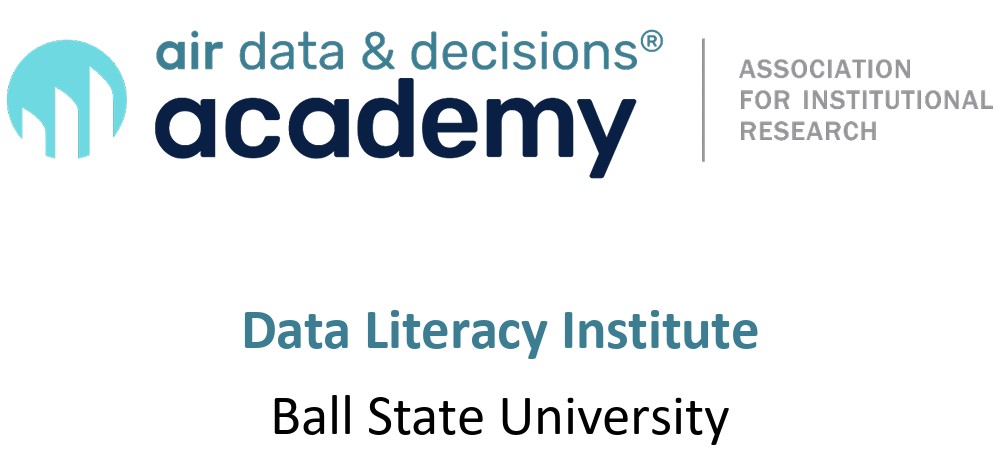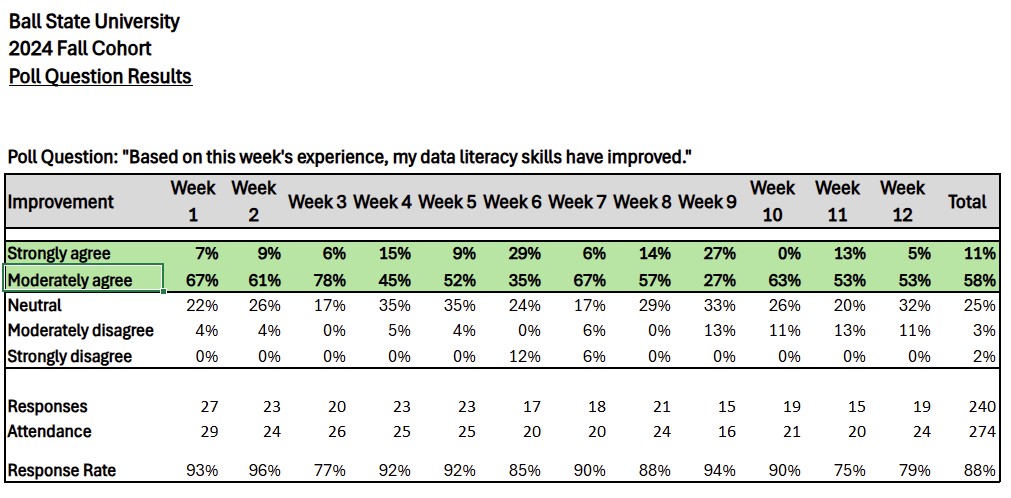Being asked to improve data literacy at a Professions-focused Undergraduate/Graduate-Doctorate Large institution can feel daunting. Where do you start, how do you scale, and how do you measure progress in a way that actually changes decisions on the ground? This post outlines what we did at Ball State University, why we chose this path, and what results we are seeing so far.
What We Mean by Data Literacy
Data literacy is the ability to find, understand, interpret, and communicate data to make sound decisions. It includes foundational concepts such as understanding data sources and structure, assessing data quality, applying basic statistical reasoning, reading and creating clear visuals, and using data ethically with appropriate attention to privacy and context.
The Scale Problem
Ball State has roughly 3,000 faculty and staff. Even if we scheduled large sessions with 60 people each, we would need 50 sessions to reach everyone one time. To build real capability we estimated at least four two hour sessions per person, which would mean 200 sessions and about 400 hours of delivery. That approach does not scale. We needed a sharper plan.
We reframed the problem with three questions:
- Who most urgently needs deeper data literacy to do their jobs well?
- Who can we partner with to deliver high quality instruction in a structured way?
- How do we extend the benefits beyond an initial cohort so the whole institution improves over time?
Focusing on the Right Audience First
When we mapped our heaviest data users, we identified a cross‑campus group of about 60 staff. Starting with this group made the work tractable. These colleagues already spend a significant portion of their time with data and could commit to intensive training. That still left two practical questions. Who would teach, and what exactly would the curriculum cover?
Choosing a Training Partner
We looked for formal training designed for higher education and selected the Data Literacy Institute offered by the Association for Institutional Research. The program runs in a semester format for cohorts up to 30 people, with a rigorous curriculum that culminates in a capstone project. The blend of instruction, practice, and applied work matched what we needed.
Through our data governance body, MIDAS, we identified the 60 participants and contracted for fall and spring cohorts. The real time sessions went well. Participants learned new skills and built relationships across units while collaborating on capstone projects. There was some building the plane while flying it, which is normal for a first year effort, but overall the experience was very strong.
Scaling Beyond the Cohorts
The first two steps solved for depth and quality. The third step was scale.
We did two things:
License and adapt the curriculum for internal use. We licensed the DLI content for Ball State so we can offer modular courses internally. With that in hand, we are developing on demand offerings in Udemy that mirror the essentials without requiring the full semester experience. Caleb Grubb in the Office of Decision Support is preparing DLI 101 and DLI 102 to give staff flexible entry points and a clear path to progression.
Extend capstones into full research projects. Capstones are excellent for learning and for surfacing high value questions, but they are not designed to produce polished institutional research. To close that gap we invited DLI graduates to join Advisory Groups that extend selected capstones into full studies. These groups are led by Joseph Finke in Institutional Research. Two projects are complete, with additional studies underway. The output includes written reports, presentations, and actionable recommendations that inform campus policy.
Outcomes
- Sixty faculty and staff have completed the intensive DLI training across two cohorts, with a third cohort under consideration.
- Internal DLI 101 and DLI 102 courses are in development for Udemy so staff can learn asynchronously and at the right depth for their roles.
- Advisory Groups have completed one extended research projects, with several more in development, turning learning into tangible institutional insight.
- Our first completed research project is on Sophomore Retention.
Also, built into the DLI are consistent check ins with attendees both in the sessions and via a weekly survey. Our results on that survey with the first cohort of attendees were generally good with the exception of Week 6 that has some known issues in the delivery (there are also open ended comments to help identify any issues). As we got closer to the end of the DLI more folks were growing a little frustrated with the length of the DLI (a whole semester and about 3-4 hours a week including work on the capstone) which argues for selecting attendees carefully. This data is shared with an eye toward continuous improvement:
What We Learned
- Start where the need is most acute. Training power users first gives us the most direct impact and since the course requires a lot of time and effort we need to make sure that time is well spent.
- Buy the experience and focus on who to deliver to. Partnering with AIR gave us a mature curriculum and experienced instructors so we could spend our time on adoption, not content creation.
- Build continuity from learning to practice. Extending capstones into formalised research projects keeps skills active and produces value for the campus.
- Plan for scale from the beginning. Licensing the content and modularizing it for on demand delivery lets us reach many more people at the level they need. Most faculty and staff do not need the level of intense training offered by the full DLI.
What’s Next?
We are evaluating the next group of 30 for intensive training and finalizing the internal DLI 101 and 102 courses. As Advisory Groups complete additional studies, we will publish findings on this blog and share summaries with campus stakeholders so that insights translate into decisions.
If you have questions about the program or would like to propose a topic for an Advisory Group study, contact us at irds@bsu.edu.
Discover more from Data Insider
Subscribe to get the latest posts sent to your email.


